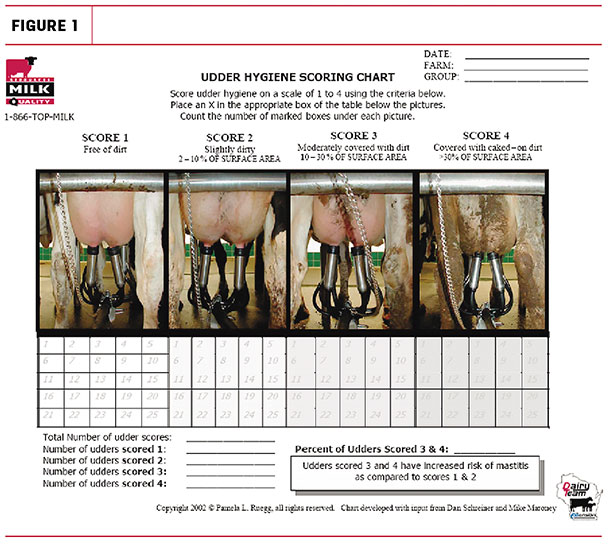No matter how the premiums or penalties that determine your check are measured, bulk tank bacterial levels are a direct reflection of the execution of on-farm standard operating procedures (SOPs), conditions of the cows’ environment and the equipment function from the freestall barn to the bulk tank.
Most dairies have some type of prevention measures in place to achieve or maintain optimal milk quality. However, many dairies only manage their milk quality by reacting to a bulk tank report. This reactionary position creates unnecessary costs – in time, chemicals, service and frustration. If you want to take your dairy to the next level, there are several data points that can be monitored long before you receive the bulk tank report. However, evaluating this data only when reacting to a change in milk quality provides limited value because you have no baseline for comparison.
Cleaning data
Whether you have a manual or fully automated cleaning system, a key factor to maintaining good milk quality is consistency of cleaning. As technology on farms advance, dairies may have a constant view of cleaning data and/or have alarms when certain parameters are breached. This allows for a faster response and reduces the possibility of negatively impacting milk quality.
However, advanced technology is not required in order to collect and record data as part of a daily or weekly on-farm SOP. Easily monitored parameters that can serve as early warnings to cleaning failures include:
- Temperatures of first rinse cycle and detergent cycles in the clean-in-place (CIP) and bulk tank washes. End temperatures are a better reflection of cleaning than beginning temperatures, but both have value.
- pH of detergent and acid cycles indicate if chemical is being consistently dosed into cycles.
- Time length of cycles may reveal whether drains are operating correctly.
Milking data
The milking process can have a significant impact on bulk tank milk quality. Forestripped milk tends to be higher in somatic cell count (SCC) and bacteria. Teat dips are designed to kill bacteria on the teat skin – when the teat is fully covered. Teats are wiped to remove soil, pre-dip and bacteria as long as the surfactant and disinfectant package of the dip can overcome the soil load.
Attaching milking units quickly reduces the chances of introducing bacteria from the parlor environment into the milking system. Keeping the parlor and milking units clean also reduces environmental contamination. However, monitoring these processes for milk quality using data can be challenging.
Milk flow data is a good indicator of the prep process. In theory, if the milkers are doing a fairly good job in the parlor with forestripping and wiping (the two tactile components of prep), cows will let their milk down without bi-modal milk flow. However, by using this data to evaluate milk quality, you are also assuming milkers are correctly dipping and attaching.
Other milking time data that reflects the milking process are liner slips and blocked claw vents. Liner slips may be an indicator of good attachment and alignment. Blocked claw vents may indicate a dirty parlor environment. However, both of these parameters should be used with caution when evaluating milker performance, as other factors outside of their control can have significant influence (such as vacuum level, liner fit, high milk flow, etc.).
If you don’t have milk meters in the parlor to monitor the milking process, a simple scoring of milk filters at the end of milking can provide valuable data. Overall, you want to see clean filters on all shifts. If one shift has significantly dirtier milk filters, it may be an indication they are not dipping and wiping teats thoroughly.
Cow/farm data
Additional data points that can help drive consistent milk quality are cow hygiene scores, teat-end cleanliness scores, bedding cultures and bulk tank cultures.
-
Cow hygiene scores (Figure 1): The correlation between cow hygiene scores and mastitis has long been established, but don’t forget that cow hygiene also impacts bulk tank bacteria levels.
 Dirty teats create challenges in the parlor. An entire pen or herd of dirty cows requires a significant investment in time to achieve clean teats, resulting in low parlor through-put and frustrated milkers. Oftentimes, milkers are forced to choose between cleaning teats well or getting behind with the milking session and, if they are milking on a rotary, there is no opportunity to spend extra time cleaning dirty teats.
Dirty teats create challenges in the parlor. An entire pen or herd of dirty cows requires a significant investment in time to achieve clean teats, resulting in low parlor through-put and frustrated milkers. Oftentimes, milkers are forced to choose between cleaning teats well or getting behind with the milking session and, if they are milking on a rotary, there is no opportunity to spend extra time cleaning dirty teats.
Monitoring cow hygiene scores on a monthly basis is a method you can use to evaluate how the “barn crew” is performing their tasks of keeping alleyways clean, grooming stalls and bedding frequency. If there are times during the year that challenge cow hygiene (i.e., wet seasons with open drylots), it may be beneficial for you to invest in a pre-dip with a high surfactant package to help loosen soil or manure on teats and make teat cleaning easier.
-
Teat-end cleanliness scores: After milkers dip and wipe cows, an alcohol swab on the teat end can be used to determine if they are cleaning teat ends or leaving soil load (and bacteria) behind and into the bulk tank. This type of analysis has limitations when overall cow hygiene is poor and/or if teat-end condition is poor.
-
Bedding cultures on new bedding, recycled bedding and used bedding may also help monitor what is happening in the barn. Even if you’ve been using the same bedding provider for years, are you certain they are still using the same original source? Occasionally, a change in bedding origination results in higher-than-normal bacterial loads coming onto the farm. Monitoring your recycled bedding against a baseline will help you evaluate the separating, drying and/or composting processes and know when changes are occurring. Analyzing used bedding over time will help determine necessary changes, such as bedding more frequently or a possible stall renovation.
- Bulk tank cultures: Knowing your farm’s baseline levels of environmental bacteria in the bulk tank when you have good milk quality may help pinpoint areas to focus on when milk quality is poor.
Most dairies tend to react to bulk tank milk quality because it takes significant effort to monitor and evaluate the influencers of milk quality on the farm. However, scoring, evaluating and interpreting results and key performance indicators (KPIs) is not something you must do alone. Involving your milk quality team – parlor leads, herd health team, veterinarians, milking equipment and chemical supplier, and other consultants – will spread out the work load.
Routinely providing graphed or charted data to all responsible employees helps them make the connection of job task to outcomes more meaningful. It’s information you can use in employee performance reviews. Employees may also see it as a competition with rewards being as simple as bragging rights or a shift party, or you might provide financial rewards such as a bonus or extra time off. Taking the next step may seem daunting, but moving from a reactionary response to a preventative stance will push your dairy to the next level of milk quality performance. ![]()
PHOTO: Taking the next step may seem daunting, but moving from a reactionary response to a preventative stance will push your dairy to the next level of milk quality performance. Courtesy images.

-
Kristy Campbell
- Manager
- DeLaval Dairy Advisory Team
- Email Kristy Campbell






